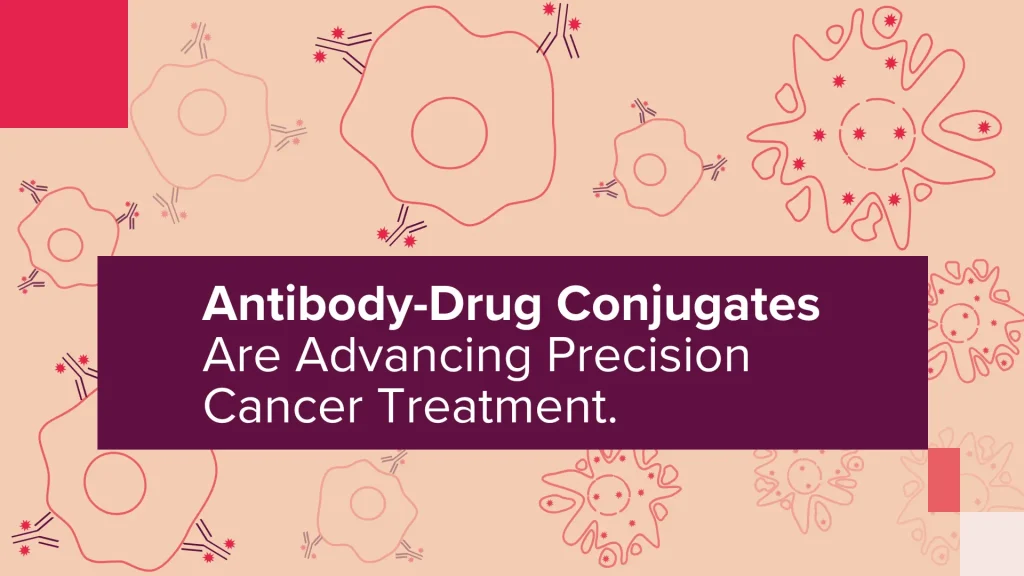February 18, 2025

Cancer treatment is undergoing a transformation, with antibody-drug conjugates (ADCs) at the forefront of this progress1. ADCs consist of a monoclonal antibody conjugated to a cytotoxic payload, offering precise targeting and a potent killing effect against cancer cells1. The potential of these targeted therapies was exemplified in the groundbreaking work of Dr Thomas Powles, Director of the Bart’s Cancer Center, in which an ADC combination treatment more than doubled the median survival of bladder cancer patients.
Dr Powles’ work has earned him a spot in Nature’s 10 and TIME’s 100 lists for most influential people in science and health in 2024. He recently joined Christopher Ung, our Chief Scientific Business Officer, on our Let’s Talk webcast to share his first-hand, in-depth insights into ADCs. Here, we break down his research success and share his thoughts on the current and future ADC treatment landscape.
Dr Powles’ bladder cancer breakthrough
Dr Powles describes bladder cancer as a ‘Cinderella cancer’ due to there being little treatment progress over the last 40 years. The traditional approach — platinum-based chemotherapy — offers patients only modest benefits, with a median survival of around one year and a progression-free survival (PFS) of just six months.
However, Dr Powles’ trial of enfortumab vedotin (EV), a nectin-4 ADC, in combination with PD-1 inhibitor pembrolizumab, redefined expectations. The treatment more than doubled the median survival of patients, from one year with standard chemotherapy to 2.5 years, and doubled the PFS.
“We had tried many times to beat platinum-based chemotherapy and always failed. This was the first time we succeeded, but we didn’t just succeed—it was transformative,” said Dr Powles. “I wouldn’t have said this two years ago, but I think we might cure bladder cancer.”
The results of the EV-pembro trial highlight the potential of ADCs to reshape the cancer treatment landscape.
Expanding horizons: the growing role of ADCs in cancer treatment
In bladder cancer, EV-pembro has already replaced the traditional platinum-based chemotherapy as the front-line treatment. Dr Powles views ADCs as a “second-generation, targeted chemotherapy” with the potential to replace traditional approaches in some cancers. In the webcast, he highlighted several areas where ADCs are already in use, and where they hold future promise:
- Breast cancer: The ADC trastuzumab deruxtecan (TDXd) has been approved to treat HER2-low breast cancers, an area where treatment options were previously limited. Research continues in potentially redefining biomarker selection to improve patient outcomes.
- Lung cancer: Lung cancer research is currently undergoing rapid developments, with several ongoing trials of ADCs targeting Trop-2 (such as sacituzumab govitecan).
- Urothelial cancer: In addition to EV-pembro, HER3-EGFR ADCs are showing promise in urothelial cancer, with an overall response rate of 43.5% in a recent trial.2
- Hematological malignancies: ADCs targeting cluster of differentiation (CD) markers are currently being explored for lymphomas and leukemia.
The future of ADC development
While current ADCs have already transformed cancer treatment in some areas, Dr Powles believes there is still significant room for improvement. With advances in technology and drug design, future ADCs could be more effective and have fewer side effects.
“Even the established ADCs have a long way to go” said Dr Powles “I want to see new payloads, I want to see improved linker molecule technology, and I want to see duality of targeting. I think some of the issues we see today, like off target toxicity, could be resolved with these advancements.” He continues: “I foresee that we’re going to see a second generation of ADCs, and it’s going to be really promising.”
AI and biomarker-driven approaches are set to be key drivers of ADC advancement. Biomarkers are already essential in selecting patients for ADC treatments, but future ADCs may require more precise patient stratification. AI-powered digital pathology tools could improve the accuracy of biomarker detection, refining patient selection to ensure that treatments reach those most likely to benefit.
With these developments on the horizon, ADCs are poised to play an even greater role in cancer treatment — potentially redefining the standard of care across multiple cancer types.
To hear more of Dr Powles first-hand insights into the future of ADCs, watch the full webcast on-demand now: Webcast – Thomas Powles – Gated | CellCarta
References
- Colombo R, Tarantino P, Rich J, et al. The Journey of Antibody–Drug Conjugates: Lessons Learned from 40 Years of Development. Cancer Discovery. 2024; 14 (11): 2089–2108.
- Ye D, Bian X, Yang T, Jiang S, et al. BL-B01D1, an EGFR x HER3 bispecific antibody-drug conjugate (ADC), in patients with locally advanced or metastatic urothelial carcinoma (UC). Ann Oncol. 2024; 35(suppl_2): S1135-S1169.

Céline Vandamme is a Scientific Business Director at CellCarta, specializing in the flow cytometry platform. With a PhD in immunology, and a broad expertise gained through her work at various academic and pharmaceutical institutions, Céline has profuse experience in designing flow cytometry assays to support immune monitoring activities in clinical trials.
You might also be interested by
CellTalk Blog
This is SPARTA: A Framework for Multiplex Immunofluorescence Analysis
November 13, 2025
More infoPosters
Artificial Intelligence-powered Spatial Analysis of Tumor Microenvironment Identifies Immune Phenotype in Non- Small Cell Lung Cancer, Colorectal Cancer and Urothelial Cancer.
October 30, 2025
More info